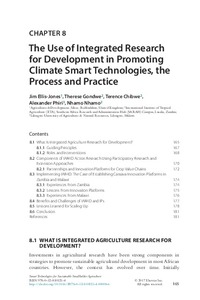| dc.contributor.author | Ellis-Jones, J. |
| dc.contributor.author | Gondwe, T.N.P. |
| dc.contributor.author | Chibwe, T. |
| dc.contributor.author | Phiri, A. |
| dc.contributor.author | Nhamo, N. |
| dc.date.accessioned | 2019-12-04T11:15:31Z |
| dc.date.available | 2019-12-04T11:15:31Z |
| dc.date.issued | 2017 |
| dc.identifier.citation | Ellis-Jones, J., Gondwe, T., Chibwe, T., Phiri, A. & Nhamo, N. (2017). The use of integrated research for development in promoting climate smart technologies, the process and practice. In N. Nhamo, D. Chikoye and T. Gondwe, Smart technologies for sustainable smallholder agriculture, Amsterdam, The Netherlands: Elsevier, (65-182). |
| dc.identifier.isbn | 978-0-12-810521-4 |
| dc.identifier.uri | https://hdl.handle.net/20.500.12478/2984 |
| dc.description.abstract | Integrated Agriculture Research for Development (IAR4D), based on the use of participatory research and extension and innovation system approaches, represents an action research process in support of development activities. This is a major shift from the traditional way of undertaking research, where researchers conceptualized and developed technologies and then passed them on to extension, who were then expected to take new technologies to farmers. Instead, innovation system approaches involving multiple stakeholders are encouraged to build partnerships for dialog finding solutions to existing challenges or seeking new opportunities, often within a commodity value chain. The strengths of an innovation system approach are its wide base in terms of stakeholders, capacity building, planned progression of involvement of different actors, and the voluntary nature of participation, which can reduce hidden costs and involve committed actors. There is untapped potential for participation and hence institutionalization of technologies with information and development networks. This is much higher within an innovation platform than using conventional linear approaches. However, there are challenges associated with engaging stakeholders in the agriculture sector, which provide both learning opportunities and future research questions. In this chapter, key issues for linking stakeholders in innovation platforms are addressed. This includes, deciding on focus, identifying challenges and opportunities, testing and modifying solutions, developing capacity, analyzing, learning, and scaling up to effectively deliver new technologies for wide use. The chapter is organized as follows: what is IAR4D; its components using participatory research and extension approaches; partnerships and innovation platforms for commodity value chains; implementing IAR4D; case studies of establishing cassava innovation platforms in Zambia and Malawi; and benefits, challenges, and lessons for scaling up. |
| dc.format.extent | 165-182 |
| dc.language.iso | en |
| dc.publisher | Elsevier |
| dc.subject | Innovation Systems |
| dc.subject | Participatory Research |
| dc.subject | Extension |
| dc.subject | Climate Change |
| dc.subject | Value Chain |
| dc.subject | Climate Smart Technologies |
| dc.subject | Iar4D |
| dc.title | The use of integrated research for development in promoting climate smart technologies, the process and practice |
| dc.type | Book Chapter |
| dc.description.version | Peer Review |
| cg.contributor.crp | Agriculture for Nutrition and Health |
| cg.contributor.crp | Grain Legumes |
| cg.contributor.affiliation | Agriculture-4-Development, UK |
| cg.contributor.affiliation | International Institute of Tropical Agriculture |
| cg.contributor.affiliation | Lilongwe University of Agriculture and Natural Resources |
| cg.coverage.region | Africa |
| cg.coverage.region | Southern Africa |
| cg.coverage.country | Malawi |
| cg.coverage.country | Zambia |
| cg.creator.identifier | Therese Gondwe: 0000-0002-4522-7060 |
| cg.creator.identifier | Nhamo: 0000-0002-1182-6014 |
| cg.authorship.types | CGIAR and developing country institute |
| cg.iitasubject | Climate Change |
| cg.iitasubject | Value Chains |
| cg.howpublished | Formally Published |
| cg.publicationplace | Amsterdam, The Netherlands |
| cg.accessibilitystatus | Limited Access |
| local.dspaceid | 94103 |
| cg.targetaudience | Scientists |
| cg.identifier.doi | http://dx.doi.org/10.1016/b978-0-12-810521-4.00008-6 |

